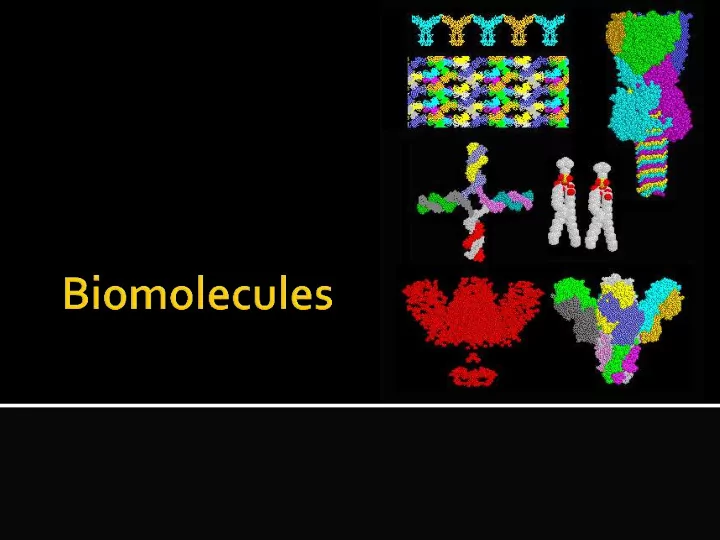

1. CONDENSATION (DEHYDRATION) Loss of H 2 O ▪ - OH (hydroxyl group) ▪ - H (hydrogen) Covalent bonds are formed Energy is expended Polymerase enzyme 2. HYDROLYSIS Addition of H 2 O Covalent bonds are broken Energy is released Hydrolase enzyme How many molecules of water are needed to completely hydrolyze a polymer that is 10 monomers long?
Sugars and polymers of sugars Classes Monosaccharides Disaccharides and oligosaccharides Polysaccharides Importance Fuel Building materials
Importance Major cell nutrients Incorporated into more complex carbohydrates Classification Location of carbonyl group (C=O) Aldose Ketose Size of C-skeleton (3- 7 C’s) Arrangement around C’s Linear form Ring form (in aqueous solutions) - H on top of plane of ring ▪ -OH on top of plane of ring ▪
IMPORTANCE Maltose (glucose + glucose) Lactose (glucose + galactose) Sucrose (glucose + fructose) FORMATION AND STRUCTURE Glycosidic linkage – covalent bond between 2 1-4 GLYCOSIDIC LINKAGE monosaccharides Condensation or dehydration synthesis reactions Draw the structure of sucrose formed from a 1-2 a) glycosidic linkage of glucose and fructose galactose formed from the 1-4 b) glycosidic linkage of glucose and galactose.
STRUCTURE AND FORMATION • Hundreds to thousands of monosaccharides joined by glycosidic linkages • Homopolysaccharides Starch ( 1,4 linkages) • IMPORTANCE Amylose • Structural polysaccharides • Amylopectin Cellulose ( 1,4 linkages) Cellulose and chitin • Storage polysaccharides • Heteropolysaccharides Starch and glycogen
large molecules assembled from smaller molecules by dehydration reactions hydrophobic and non- polar glycerol + fatty acid fat fatty acids have long C- skeletons (16-18 atoms) with a carboxyl end ester linkages are formed when 3 fatty acids join to glycerol Functions Energy storage Cushioning of vital organs Insulation
glycerol + 2 fatty acids and phosphate group amphipathic hydrophobic tails hydrophilic heads assemble into bilayers major components of cell membranes
C-skeleton with four fused rings Vary in the functional group attached to the rings Cholesterol Cell membranes Used for synthesis of sex hormones ▪ Testosterone ▪ Estrogen
Amino acids arranged in a linear chain and folded into a globular form Amino acids Structure Carboxyl (-COOH) end Amino (-NH2) end R (variable) group attached to the -Carbon Classification Nonpolar Polar Charged (acidic/basic)
http://legacy.owensboro.kctcs.edu/gcaplan/anat/notes/amino_acid_structure_2.jpg
http://www.personal.psu.edu/staff/m/b/mbt102/bisci4online/chemistry/charges.gif
Sequence of amino acids in a polypeptide chain Change in one amino acid may change properties of entire chain Glu Val substitution causes sickle cell anemia
Coiling/folding due to H-bond formation between carboxyl and amino groups of non- adjacent amino acids. R groups are NOT involved.
3d structure resulting from folding of the 2 structures stabilized by bonds formed between amino acid R groups forms many shapes (e.g. globular compact proteins, fibrous elongated proteins) disruption denaturation
Present in some proteins whose tertiary structures (subunits) join to form a protein complex
Structure affected by pH salt concentration presence of solvents temperature Chaperone proteins in cell help in refolding proteins
DNA (deoxyribonucleic acid) Provides directions for own replication Directs RNA synthesis Controls protein synthesis RNA (ribonucleic acid) mRNA directs protein synthesis in the ribosome tRNA transfers a specific amino acid to a polypeptide chain rRNA combines with a protein to make up a ribosome
Nucleotide Nucleoside Phosphate Nitrogenous base Pentose sugar
5’ end 3’ end
Recommend
More recommend